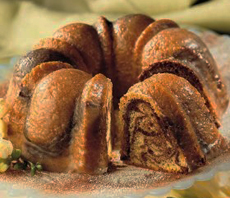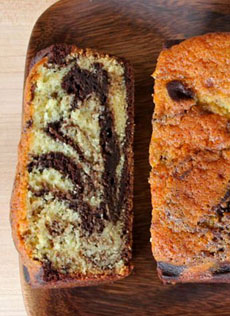Recipe: Classic German Marble Cake From Scratch
Marble Cake History
This is Page 1 of a two-page article. Click on the black links below to visit other pages.
Overview
This recipe is courtesy Tori Avey and Zabar’s, which sent us this recipe. Tori blogs under the name The Shiksa In The Kitchen.
The History Of Marble Cake
According to Tori’s research, the idea of marbling two different colored batters into a cake originated in nineteenth-century Germany. Typically, a mix of darker-color ingredients were swirled into a yellow cake batter to create a marbling effect.
Marble cake made its way to America with German immigrants before the Civil War. Originally the cakes were marbled with molasses and spices. The first recorded Jewish recipe for a marble cake appears in an American cookbook called Aunt Babette’s Cook Book: Foreign and Domestic Receipts for the Household, published in 1889 (you can still buy it, in an edition reprinted by Cornell University in 2009).
Aunt Babette’s recipe replaced the molasses and spice marbling with chocolate marbling, a reflection of the new American obsession with chocolate. Chocolat became affordable to most people in 1895, when Milton S. Hershey. In 1895 introduced the Hershey Bar, made with modern, mass-production techniques that cut the expense of production.
Marble cake remained popular throughout the 19th and 20th centuries. After World War II, an influx of German-Jewish bakers spread awareness of marble cake and other German-style cakes and pastries. However, this style of baking began to wane in the 1970s and 1980s, as those bakers retired and Americans focused on other styles of baking, including French recipes from the growing ranks of classically-trained American culinary school graduates. |
|

Marble cake made in a bundt pan. Photo courtesy Mrs. Beasley’s. |
According to the Encyclopedia of Jewish Food by Gil Marks, “Many Jewish bakeries in the New York area in the 1950’s through the 1970’s would distinctively add a small amount of almond extract to the chocolate marble cake, creating a version sometimes referred to as a ‘German Marble Cake,’ that had a characteristic almond aroma.”
In our experience, as a New Yorker during that time frame, most marble cakes were made in chocolate-iced loaves. They were our favorite childhood cake—and we
Tory Avery’s German Marble Cake recipe is traditional with one modern twist: She adds vanilla pudding mix to the batter for moisture and another flavor element.
And now, on to the recipe!
Continue To Page 2: Marble Cake Recipe
Go To The Article Index Above
Recipe © Copyright Tori Avey. Other content
Lifestyle Direct, Inc. All rights reserved. Images are the copyright of their individual owners.

|



